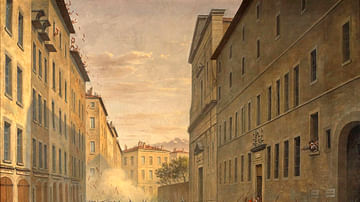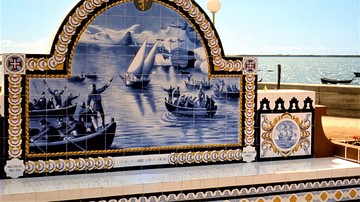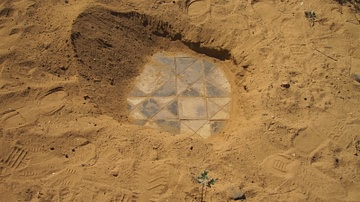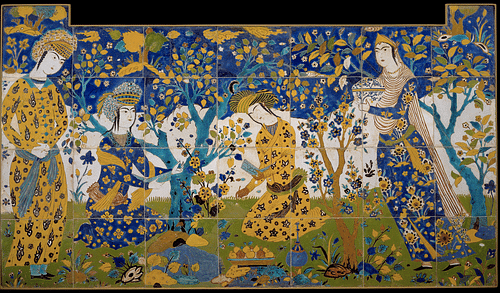
Persian Haft Rang tiles, also known as seven-colored tiles, are highly decorative glazed tiles used to adorn the exteriors and interiors of both secular and religious buildings. The tiles first came to prominence from the 15th century and artists frequently chose to decorate them with painted designs showing plants, birds, people, and calligraphy.
Earlier Persian Tiles
One of the most prevalent and important forms of decoration in Persian architecture is tile work which, throughout history, has bestowed a unique and charming aesthetic characteristic upon the region's buildings. The oldest examples of this method in Persia can be dated back to the 13th century BCE in Khuzistan, where glazed bricks were used to adorn the walls of Chogha Zanbīl, an ancient Elamite temple complex near Susa. The same technique was also used during the Achaemenid empire in the palaces of Susa and Persepolis, a portion of which can be seen in two friezes known as the Lions and Archers frieze.
It was during the Islamic period that Persian tile work reached its full potential and artists began exploring various methods and designs to elevate this art to its apogee. Maintaining the ancient practices of the pre-Islamic era, the artists modified both the shapes and thickness of the tiles, as well as the motifs used to decorate them. The tiles became relatively thinner since they were now used to cover surfaces built with burnt rather than sun-dried bricks and as for the shapes, it can be seen that the more rectangular forms are now accompanied by more complex shapes such as four and eight-point stars. As Arthur Upham Pope notes:
The development of colored tiles is the most important Persian achievement in architectural ornament. (Pope, 2021, p43)
One can observe a close connection between Persian pottery and tile work techniques which, depending on the differing demands of the patrons, would also change over time. One of the main and best-known types of Persian tiles is Haft Rang (seven-colored).
Development
In the late 15th and 16th centuries during the Timurid and Safavid dynasties, a new technique in tile work came to replace the widely used technique of mosaic faience which had developed gradually from the ancient colored and glazed brick technique. The mosaic faience was created by following a series of steps consisting of designing a pattern to the exact scale, specifying and firing the colors separately, and cutting the tiles into small units which would then be arranged according to the design and finally covered with a layer of plaster to hold the whole piece together. Due to the amount of time and expense that it took to adorn the buildings with mosaic faience, a new technique was developed which was both cheaper and faster to work with; the Haft Rang tile. With this new technique, there was no need to create the design out of pieces of cut tile or to create a preparatory drawing to exact scale, since now the artist was able to paint directly on the tile itself. It must be mentioned that because the Haft Rang tiles were directly plastered onto the walls, in comparison to mosaic faience, they were more prone to damage over time. This technique lasted until the Qajar dynasty (1789-1925) but slowly faded into the background during the later years of this period.
Characteristics
As mentioned, the Haft Rang tile was both cheaper and less time-consuming to create. One reason for such efficiency was that instead of the small pieces of tiles in the technique of mosaic faience, the tiles were now cut into different size squares which together would form a much larger piece and cover a much vaster surface. Another reason was that while in the technique of mosaic faience each color was fired separately, the Haft Rang tiles gave the artist the possibility to fire all the colors at the same time, each color separated from its adjacent colors with a manganese outline to avoid them from mixing. Although this approach had its downsides as well; since each color originally required a specific firing point to reach its most vivid and brilliant consistency, this technique decreased the richness of the colors by firing them all at the same temperature. That being said, a great amount of time was saved in the process of their execution which was the main goal. Some sources believe that one of the reasons for the development of Haft Rang tiles and the need for efficiency in time and expense was the project of decorating the Abbasi Great Mosque in Isfahan that required covering a vast surface with tile work in a rather short time which was simply not possible with the technique of mosaic faience, urging the artists to develop this new technique.
In the technique of Haft Rang, the possibility of firing all the colors at the same time, the ability to draw directly on the tile itself, as well as the tile’s larger surface gave the artists an opportunity to explore various patterns and designs with higher levels of detail and accuracy such as the illustration of human figures. It was not possible to execute this degree of accuracy with the technique of mosaic faience. Depending on the use of the building, be it secular or religious, the patterns ranged from foliage and animal patterns and figures to beautiful pieces of calligraphy. While foliage designs and calligraphies could have been used in the decorations of both secular and religious buildings, the animal and human figures were mostly kept for the decoration of secular buildings.
Symbolic plants and natural forms used from prehistoric time expressed fertility and abundance… The Arabic alphabet was developed by the Persians into an amazing variety of beautiful forms which were incorporated into every part of the mosques so that the building virtually becomes the word of God.
(Pope, Persian Architecture, 134)
As mentioned above, the patterns used to decorate the Haft Rang tiles were diverse, some of which had their origins in the pre-Islamic era, such as the plant and natural forms which expressed fertility and abundance. One of the reasons for such symbolism was their repetitive nature which gave the artists the possibility to expand the forms endlessly. On the other hand, calligraphic designs were developed during the Islamic period when the alphabet was transformed into beautiful forms by Persian artists. Whether used in conjunction with other patterns or as separate designs, they were in perfect harmony with the natural motifs and forms.
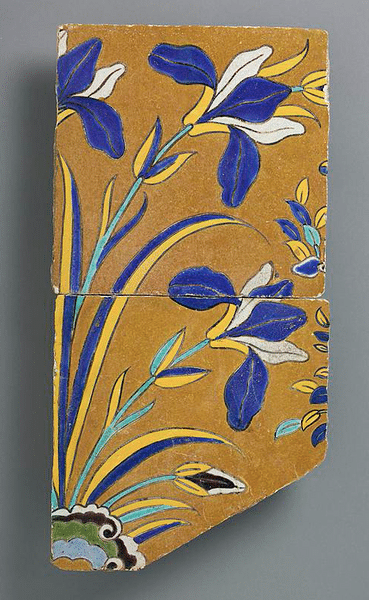
Although the name of the technique is Haft Rang, that does not necessarily mean that all seven colors were used in each piece of tile or even in the composition as a whole, even if in some instances that might have been the case. In some examples of Haft Rang tiles, the artist has even chosen to use only two colors to execute the design such as the beautiful pieces of white calligraphy which are executed on a cobalt blue background, representing beauty in simplicity. Some of the main colors used in this technique are black, white, turquoise, yellow, rose pink, and cobalt blue.
Well-known Examples
Built in the late 19th century during the Qajar dynasty, Nasir al-Mulk is without a doubt one of the most well-known mosques in Iran due to its unique aesthetic and decorative features. Located in Shiraz, one of the reasons that Nasir al-Mulk mosque attracts so many visitors throughout the year is its colorful stained glass windows that adorn the interior of the mosque with hues of charming colors, giving the space an otherworldly and spiritual sense. Another reason for the mosque’s popularity is its interior tile work. Decorated with Haft Rang tiles of mainly rose color, Nasir al-Mulk mosque is also known as the pink mosque. The Haft Rang tiles can also be seen in the exterior, decorating the walls of the mosque’s courtyard with colors such as blue, pink, and yellow.
The Haft Rang tiles of Shiraz are particularly distinct from other regions of Iran due to their unique glazing as well as the abundant use of Gol o Morgh (flower and bird) motif in vivid colors, especially roses. Other buildings in Shiraz that are also decorated with Haft Rang tiles are Afif-Abad garden (the Gulshan garden), Qavam house (Narenjestan-e Ghavam), and Vakil mosque.
Another monument that is known for its Haft Rang tile work decorations is the Abbasi Great mosque, built during the Safavid dynasty and to the order of Shah Abbas I (also known as Shah Abbas the Great (r. 1588 - 1629 CE). The Shah had demanded the mosque and its construction to be completed before his death, thus the artists and architects came up with shortcuts to speed up the process. One such shortcut, as mentioned earlier, was to replace the mosaic faience technique with Haft Rang tiles in order to cut down the time spent on decorating the building which contained vast surfaces, making the Abbasi Great mosque one of the fine examples of Haft Rang tile work.
Conclusion
Throughout its history, Persia has remained one of the most important centers for the development and evolution of tile work to the point which tile decorations have now become an inseparable part and an important characteristic of its architecture. From glazed bricks to mosaic faience, luster, and the seven-colored tiles, Persians have played an important role in forming some of the now most widely used tile work techniques.





